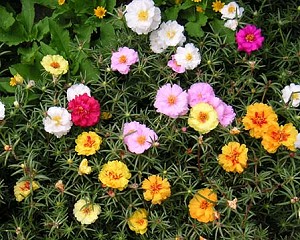
|
|
Portulaca
grandiflora
|
Portulaca
- Portulalca spp.
Portulaca
is a small group of trailing annuals. P. grandiflora, Sun Plant, is a
popular kind native of Brazil. The sprawling stems grow 4 or 5 inches
long and are clothed with somewhat succulent, cylindrical leaves.
Several large flowers, up to an inch in diameter, grow at the ends of
the stems. They come in an array of bright, beautiful colors; purple,
scarlet, yellow and pink are just a few. There are both single- and
double-flowered varieties. P. oleracea, the common Purslane, can grow up
to 6 inches high. It is from southern Europe and can be an annoying
garden weed. This and a variety of it, P. oleracea variety sativa can be
grown in the vegetable garden. Even the weedy wild Purslane is good used
as a potherb or in a salad, but the cultivated variety is larger and
more tender.
Purslane
is a trailing annual with reddish, fleshy stems whose joints will form
roots when they come in contact with the ground. The fleshy leaves are
spoon shaped and up to 2 inches long and the small flowers are a
brilliant yellow. Cultivated Purslane (also known as Pusley &
Verdolaga) grows about 3 inches high and 12 to 18 inches wide. The
plants are succulent and delicate.
The diversity of Portulaca names and meanings already gives an idea of
the age and geographical dispersion of purslane's cultivation or use. On
the basis of historical, archaeological and linguistic documentation, De
Candolle thought that this species was cultivated more than 4 000 years
ago. Its common names come from different roots: lonica or louina (Sanskrit),
koursa (Hindustani), kholza and perpehen (Persian), adrajne agria (Greek),
portulaca (Latin, which means "little door", because of the
way its capsule opens).
As a medicinal plant, it is considered to have antiscorbutic, diuretic
and cooling properties. Dioscorides already recognized its medicinal
powers: these were anti-inflammatory (eyes) and analgesic (headache),
emollient and soothing, antifebrifuge (in juice) and anthelmintic. He
also says that "it reduces the desire to fornicate". In the
latter sense, other authors also mention its anaphrodisiac powers (1837
Codex of the Spanish Pharmacopoeia), including this plant among the
"four cold seeds", together with chicory, endive and lettuce.
The anaphrodisiac effect is perhaps due to the presence of norepinephrin,
a precursor of adrenalin, which causes a reduction in the blood flow
through constriction of the main arteries. The juice and aqueous
extracts from the plant Portulaca oleracea have been used in West Africa
for a variety of medical purposes, and extracts were previously shown to
have muscle relaxant properties on isolated nerve-muscle preparations.
Purslane was one of the most widespread horticultural plants in the Old
World since distant times. It was taken to America where it was
naturalized, as in Europe, in gardens, among rubble and at waysides. It
originates from the region extending from the western Himalayas to
southern Russia and Greece. In eastern Asia it does not seem to be
spontaneous. In Greece it is spontaneous and cultivated. Vavilov (1951)
categorizes it in the Mediterranean countries of the Near East and
central Asia as a weed and vegetable.
Nowadays it is distributed over the hot temperate zones of a great part
of the world. Together with other species of the genus it occurs as a
weed in the majority of tropical and subtropical countries.
It is cultivated in the United Kingdom, the Netherlands and other
European countries. It is a popular winter vegetable in northern India.
In Spain, it very frequently occurs as a volunteer, but it is very rare
as a crop. In spite of Spanish disregard for this plant, it is still
valued in many Latin American countries where it was introduced.
Purslane has been eaten as a vegetable, particularly fresh. In England
in the seventeenth century, the cooks of Charles II used to add its
leaves to all salads, perhaps to satisfy the king's taste or else for
its digestive properties.
Not only the leaves, but also the stems and rootless plantlets can be
eaten raw and fresh. Columela mentions their being eaten pickled with
salt and vinegar. Purslane has a pleasant acidic flavour and is very
juicy. In Spain, it is usually eaten at a more advanced stage of growth,
after cooking. It is also delicious boiled and in omelettes. Sauteed in
butter or fried, it is used in soups, broths, salads and sauces.
Together with sorrel, it forms part of the French soup bonne femme.
Recipes are also known for purslane and pea soups. In Greece a
deliciously simple salad is a few lettuce leaves, fresh stalks of
Purslane drizzled with olive oil.
To complete the range of its applications, one could mention its use as
an insecticide, in which case its juice is poured on to anthills.
Source:
http://www.botany.com/portulaca.html
http://www.herbcollege.com/herbofthemonth.asp?id=63
http://www.fao.org/docrep/t0646e/T0646E0t.htm
